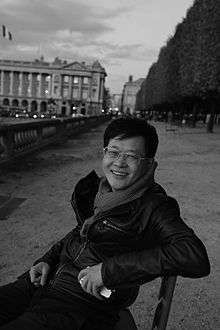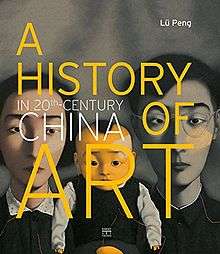Lv Peng

Lv Peng (also Lü Peng; Chinese: 吕澎) is a Chinese curator, critic and art historian. He has engaged extensively with Chinese modern and contemporary art for over thirty years.[1]
Education
Born in 1956 in Chongqing, Sichuan, Lv graduated from the Political Studies Department of Sichuan Normal University in 1982, and was awarded a PhD in Critical Art Theory from the China Academy of Art in 2004.[2]
Career
Lv was Editor in Chief of the journal Theatre and Film from 1982–85 and subsequently served as Vice-Secretary of the Sichuan Dramatists Society from 1986-90. He then held the position of Executive Editor at the magazine Art & Market and in 1992 he served as Artistic Director of the Guangzhou Biennale (officially titled the First Guangzhou Biennial Art Fair). His curatorial accomplishments include:- “A Gift to Marco Polo” (Venice Biennale, 2009), which showcased eight of China’s most prominent contemporary artists; “Reshaping History” (Beijing, 2010), a large-scale exposition presenting more than one thousand works by nearly two hundred of the most innovative Chinese artists of the first decade of the 21st century; and “Pure Views: New Painting from China” (Louise Blouin Foundation, Frieze, London, 2010), “Pure Views: New Painting from China” (Asia Art Museum, San Francisco, 2011); and the 2011 Chengdu Biennale.
Lv currently serves as Director of Chengdu's Museum of Contemporary Art, Director of CHINART, the management agency of Chinese art institutions, and is Associate Professor of the Department of Art History and Theory at the China Academy of Art, Hangzhou, Zhejiang Province. He serves as a consulting authority for a number of Chinese government organisations and mainland Chinese companies.
A History of Art in 20th-century China

This book is Lv Peng's recent monograph of modern Chinese art, which is available in English. In the preface, he confessed that he was influenced by many Western art history books and methodologies, while viewing and writing about Chinese art especially the modern Chinese art in the age of globalisation, a set of localised theories was necessary:
In the course of China’s reform and opening, I read Herbert Read’s Concise History of Western Painting (Frederick A. Praeger, New York 1959). As for H.H. Arnason’s History of Modern Art: Painting, Sculpture, Architecture (Prentice-Hall, Englewood Cliffs, New Jersey 1978) and Ernest H. Gombrich’s The Story of Art (Phaidon Press Limited, 1983, 1984), I did not read them until a few years after graduation. These western works of art history had a big influence on me. But when confronting China’s ‘modern’ or ‘contemporary’ art, I felt the need to adopt a different method more suited to the subject. In view of the uniqueness of Chinese art and its context, I established a method of historical judgment based on a special background of politics, economics, culture and clashing civilizations. In my ‘Preface’ to the first Chinese edition I wrote of this in detail.[3]
Bibliography
- Modern European Aesthetics of Painting (Lingnan Fine Arts Press, 1989)
- Modern Painting: New Imagery Language (Shandong Literature and Art Press, 1987)
- Art-Revelation of Man (Lingnan Fine Arts Press, 1990)
- (with Yi Dan) Twentieth-Century Art Culture (Hunan Fine Arts Press, 1990)
- Critique of Modern Art and Culture (Sichuan Fine Arts Press, 1992);
- (with Yi Dan) History of China Modern Art: 1979-1989 (Hunan Fine Arts Press, 1992)
- Art Operation (Chengdu Publishing House, 1994)
- History of China Modern Art: 1990-1999 (Hunan Fine Arts Press, 2000)
- Pure Views--Remote from Streams and Mountain: Chinese Landscape Painting in the 10th--13th Centuries (Chinese People’s University Press, 2004);
- A History of Art in Twentieth-Century China (Peking University Press, 2006; New Star Press, 2013)
- Artists in Art History (Hunan Fine Arts Press, 2008)
- The Story of “Art” in China (Peking University Press, 2010)
- A History of Art in China year by year [from 1900 to 2010], 2012, Chinese Young Publishing House
- Documents of Chinese art in Twentieth Century: A Sourcebook [with Kong Lin-wei], 2012
References
- ↑ Gong, Joshua (Jun 2014). "Lv Peng and his Chinese art history in operation, since 1986" (PDF). Journal of Art Historiography.
- ↑ "Asia Art Archive". www.aaa.org.hk. Retrieved 2016-01-29.
- ↑ Lu, Peng (2013). A History of Art in 20th-Century China. Paris: Somogy éditions d’art. ISBN 978-2-7572-0696-6.